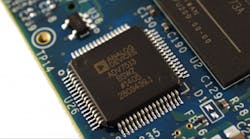Analog Devices (ADI) is acquiring Linear Technology Corp. (LLTC) for $14.8 billion, continuing the trend of big consolidations within the semiconductor sector. ADI reported annual semiconductor revenue of $3.4 billion in 2015, while LLTC revenue was $1.4 billion.
After examining the potential margin improvement, product portfolio, and end-market focuses of these two companies, Jonathan Liao, senior analyst, power semiconductors, IHS Markit, says the acquisition will increase the competitiveness of ADI in several end markets.
In Research Note: Analog Devices to acquire Linear Technology, Liao says both ADI and LLTC boast “decent gross margins and operating margins,” which hover around 37% and 7%, respectively. If correctly executed, Liao feels that the acquisition of LLTC by ADI will help boost margin performance, from a gross margin and operating margin standpoint.
“The resulting company is expected to post gross margins in the high-60s and operating margins in the mid-30s,” he writes. “If integrated properly, the resulting figures provide a substantial margin improvement for a company with $4.8 billion dollars in annual revenue.”
With over 80% of its products being general-purpose analog devices used in various end markets in the industry (including computing, communications, industrial, automotive, and consumer electronics), ADI specializes in converters, amplifiers, radio frequency (RF), signal processing, and power management devices.
According to Liao, the company also invests in high-volume manufacturing processes for both analog and digital products. “While some ADI products are created for the high-performance market and compete directly with LLTC,” he writes, “most of their goods are general-purpose devices made for medium- to high-volume customers. ADI has a massive customer base with over 100,000 customers globally.”
On paper, Liao points out that the product portfolios of ADI and LLTC both compete and complement each other, as they are targeted for slightly different customer sets. The combined company will be competitive in offering both high-performance and high-volume products to its customers. The primary competitors in this market segment are Texas Instruments, Maxim Integrated, and Infineon.
In the automotive market, ADI grew its automotive business from 12%t of total revenue to nearly 16% in 2015. In the industrial market, both ADI and LLTC have been growing successfully. “The integration of their product portfolios will provide additional weapons for the combined entity to sell more high-performance products into the industrial market at a higher volume,” Liao predicts.
Overall, Liao says ADI will become a much stronger player in the analog market with the acquisition of LLTC. “This move will create a ripple effect for other large suppliers to reevaluate their scaling strategies,” he writes, “and may result in additional acquisitions.”









